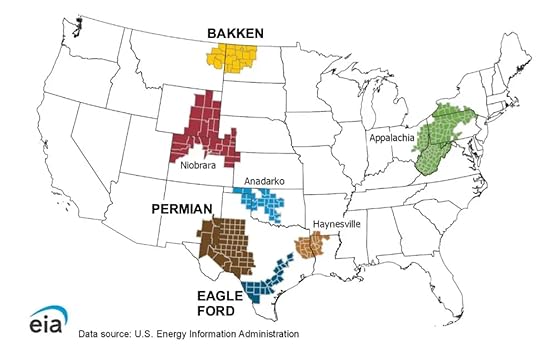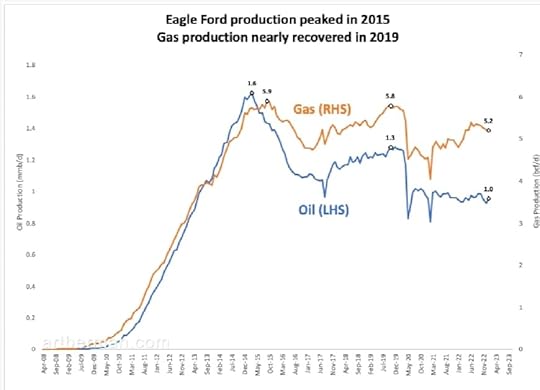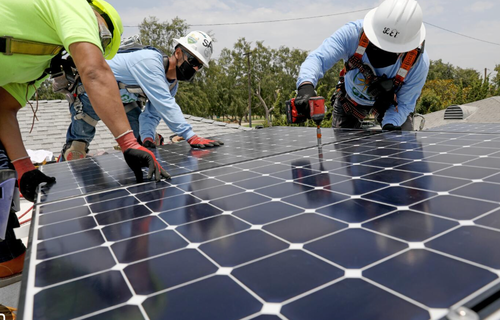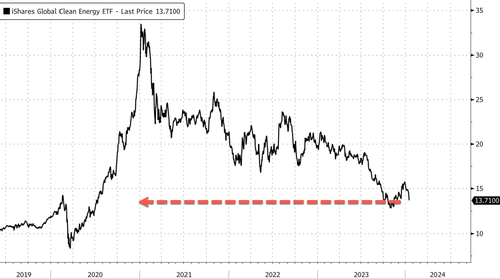Steve Bull's Blog, page 80
January 19, 2024
“Worried About Next Two Months”: Solar Firms Running Out Of Cash In California
The solar industry in California is facing significant headwinds following the implementation of a new policy in April, which reduced incentives that had encouraged homeowners to install solar systems.
Bloomberg reports the California Solar & Storage Association has found about 63% of its 400 solar installer members have reported cash flow issues because the new policy crushed consumer demand.
Since last April, sales of rooftop solar systems across the state have crashed 85% in the most recent months of 2023 compared to similar periods one year before, according to solar firm Ohm Analytics.
On Wednesday, California Solar and Storage Association Executive Director Bernadette Del Chiaro told an audience at the Intersolar North America conference in San Diego that 25 to 30 solar companies have already closed shop or abandoned the state.
“We are worried about the next two months,” she said. “We think a lot more fallout may be coming.”
Besides a reduction in incentives, higher interest rates and expensive panels have also curbed demand. This means that solar installers have a dismal pipeline of work through the year’s first half.
Meanwhile, a Bloomberg MLIV Pulse survey of professional and retail investors from late last year found the green energy downturn will last well into 2024.
iShares Global Clean Energy ETF has nearly roundtriped Covid lows.
The ownership portfolio of the iShares Global Clean Energy ETF shows solar, wind, and hydrogen stocks have been clubbed like a baby seal over the past year.
Central Banks Will Keep Gobbling Gold in 2024
The first half of 2023 was a record-breaking moment for central bank gold buying, led by none other than China and Russia. Organizations like the World Gold Council reported a staggering increase compared to 2022:
“On a year-to-date basis, central banks have bought an astonishing net 800t, 14% higher than the same period last year.”
Whether or not The January Effect will apply to the gold price as we finish the first month of 2024, there are plenty of indicators that the central bank buying spree will continue for at least the first half of the new year. Accelerating de-dollarization is just one factor, as powerhouses like China and Russia continue strategically moving further and further from the grips of USD hegemony.
Of course, actions by the Biden administration to isolate Russia with sanctions in the wake of the Ukraine conflict only provide further impetus for the Russians to continue divesting in any way they can from the US dollar. Combined with a volatile ruble and a wave of new American spending to feed its proxy wars in Ukraine and Israel, it only makes sense that Russia’s gold coffers will continue to grow.
You can also bet on China and Russia buying significantly more gold than what gets reported publicly, so the real numbers are always higher than they seem. As Jim Richards has pointed out many times, such as in this tweet from Q1 last year, countries like Russia and China hold gold acquired through off-the-books buying programs that far exceed what they officially claim:
“Central Bank of Russia reported a gain of 30 metric tonnes in its gold reserves. That’s after a year of flatlining more likely due to non-reporting than non-acquisition. Nice to see Russia back in the game.”
…click on the above link to read the rest…
Is it Too Late for Sustainable Development?
Dennis Meadows thinks so. Forty years after his book The Limits to Growth, he explains why
 Courtesy of Dennis Meadows
Courtesy of Dennis MeadowsOn March 2, 1972, a team of experts from MIT presented a groundbreaking report called The Limits to Growth to scientists, journalists and others assembled at the Smithsonian Castle. Released days later in book form, the study was one of the first to use computer modeling to address a centuries-old question: When will the population outgrow the planet and the natural resources it has to offer?
The researchers, led by scientist Dennis Meadows, warned that if current trends in population, industrialization, pollution, food production and resource depletion continued, that dark time—marked by a plummeting population, a contracting economy and environmental collapse—would come within 100 years.
In four decades, The Limits to Growth has sold over ten million copies in more than 30 languages. The book is part of the canon of great environmental literature of the 20th century. Yet, the public has done little to avert the disaster it foretells.
To mark the report’s 40th anniversary, experts gathered in Washington, D.C. on March 1. Meadows and Jorgen Randers, two authors of The Limits to Growth, and other speakers discussed the challenges of forging ahead into a sustainable future at “Perspectives on Limits to Growth: Challenges to Building a Sustainable Planet,” a symposium hosted by the Smithsonian Institution and the Club of Rome, the global think tank that sponsored the original report.
I spoke with Meadows, who retired in 2004 after 35 years as a professor at MIT, Dartmouth College and the University of New Hampshire. We discussed the report and why he feels it is too late for sustainable development and it is now time for resilience.
…click on the above link to read the rest…
January 18, 2024
Why Is Society Still Mired in Mainstream Thinking?

Eagle Rock Train Station, Eagle Rock, Virginia
In my last article, I spent a considerable amount of time describing how a large part of society today is still mired in mainstream thinking and I pointed out how I don’t see or expect the possibility that much will change in the future based upon a general lack of interest in the subject of ecological overshoot and collapse along with the myriad symptom predicaments that overshoot produces. Much of the material is subject matter that I have covered here before, although some of that (subject matter) was covered a considerable while back.
It’s just that I see so much material consistently which is based on what amounts to unicorn magic pixie dust rather than actual science or even common sense once one understands the basics of overshoot. Take for instance this approach from Simon Michaux, which has already been attempted in many different forms in the past, most famously as The Venus Project. Attempting such projects entirely ignores ecological overshoot and the simple fact that civilization itself is unsustainable. Michaux made himself widely known for his telling the “Captains of Industry” that their plan to replace fossil fuels with non-renewable “renewable” energy harvesting devices, simply stated, would not work. So, his plan now has replaced these devices with thorium modular nuclear reactors and he is embarking on a project to build a “radical tomorrow.” Unfortunately, this project is destined for failure. It isn’t how civilization is powered that is the issue, it is the fact that civilization is built on the platform of technology use, making BOTH of those systems unsustainable. It is precisely the power of technology to remove or reduce negative feedbacks allowing for population growth which then feeds back into a self-reinforcing positive feedback loop of more people, more technology use, and increasing overshoot. Powering it differently won’t change anything – the systems themselves will remain unsustainable.
…click on the above link to read the rest…
A Primer For American Patriots And Preppers Facing An Uncertain Future

The average patriot (or prepper) is usually a middle class conservative or libertarian with a tendency towards independent thinking and some experience with economic struggle in their past. Most of us have made something of ourselves from very little, or, we had parents that made something of themselves from very little and we watched as children while they climbed their way up the ladder through hard work and merit.
Our philosphy is based on experience and a willingness to look beyond the veil. Most of the western public is bombarded with endless messaging about how stable and safe and “prosperous” our society is. We are constantly slapped in the face with propaganda telling us that patriots are not only crazy, but also dangerous. We are the bumbling bad guys in every film and TV show. We’re the “extremists” that refuse to accept that the system works, and if we would just stop trying to be independent from the system, we will find safety and happiness.
We are told a lot of things that aren’t true, and this is really the first thing that sets the preparedness culture apart from everyone else – A healthy sense of skepticism when it comes to establishment claims and mainstream assumptions. We will NOT be sitting idle listening to the band play while the Titanic sinks. We understand, however, that there’s a considerable number of people out there that are content to do so…
There are numerous and unique motivations for people who delve into the patriot life and I think there’s a perception that it requires some kind of abnormal shift in routine or a complete upending of one’s existence. If you become a patriot or prepper you have to live in a compound and wear army garb everyday and be suspicious of everyone…
…click on the above link to read the rest…
Meet the Thought Police
 Meet the Thought Police
Meet the Thought PoliceSo, my trial for thoughtcrimes in New Normal Germany takes place next Tuesday, January 23rd. It will likely be a one-day affair. It’s open to the public, so, if you’re in Berlin, you can come and watch at the Berlin District Court, Turmstraße 91, Room 371. The proceedings are scheduled to begin at 12:00 noon.
Yes, that’s right, the German authorities are actually putting me on trial for my thoughtcrimes. I stand accused of criminal tweeting because I mocked the New Normal German authorities and pointed out one of their many lies. Here are the two thoughtcrime Tweets at issue.

The one on the left reads, “The masks are ideological-conformity symbols. That is all they are. That is all they have ever been. Stop acting like they have ever been anything else, or get used to wearing them.” The one on the right is a quote by Karl Lauterbach, who, believe it or not, is still the Health Minister of Germany. It reads “The masks always send out a signal.”
The image is from the cover art of my book The Rise of the New Normal Reich: Consent Factory Essays, Vol. III (2020-2021), which was banned in Germany by Amazon, Inc. two days after I tweeted those Tweets … which was also when the German authorities launched the criminal investigation that led to my prosecution and instructed Twitter to censor the Tweets.
Let me back up a bit, and tell you the whole story.
What happened is, I tweeted those two Tweets, and they came to the attention of the Hessen CyberCompetenceCenter (“Hessen 3C”), a department of another department of the Interior Ministry of the Federal State of Hesse. The Hessen CyberCompetenceCenter then reported my Tweets to Germany’s Federal Criminal Police Office (Bundeskriminalamt), which launched a criminal investigation of me.
…click on the above link to read the rest…
China’s Coal Production Hit a New Record High in 2023
Higher power demand and efforts to boost energy security pushed China’s coal production to a record-high level in 2023, according to official statistics data published on Wednesday.
Chinese coal output rose by 2.9% year-over-year to 4.66 billion metric tons in 2023, per data from China’s National Bureau of Statistics reported by Reuters.
Coal imports also rose last year, as some domestic mining operations were suspended for some time in 2023 due to safety inspections and concerns.
Higher demand after the COVID restrictions were lifted and higher domestic coal prices led to record-high coal imports into China, which soared by 61.8% year-on-year to 474.42 million metric tons in 2023, data from the General Administration of Customs showed last week.
In the latter part of 2023, China ramped up coal and natural gas production, imports, and consumption as its electricity demand jumped in the second half and looks to hit a record-high winter peak demand.
Chinese authorities have been keen to avoid a repeat of the 2022 shortages and spiking prices and have instructed utilities and producers to maximize imports and output before the winter.
China continues to rely on coal and coal-fired power generation to meet its growing power demand, and despite being the world’s top investor in solar and wind capacity, it also plans a lot of new coal-fired electricity capacity.
During the first half of 2023 alone, China approved more than 50 GW of new coal power, Greenpeace said in a report this year. That’s more than it did in all of 2021, the environmental campaign group said.
China’s coal demand is expected to drop this year and plateau through 2026, and global demand is set to decline to 2026, “but China will have the last word,” the International Energy Agency (IEA) said in its Coal 2023 annual report.
The outlook for coal in China will be significantly affected in the coming years by the pace of its clean energy deployment, weather conditions, and structural shifts in the Chinese economy, according to the agency.
Eagle Ford Shale–A Preview of Permian Decline

The Eagle Ford Shale was the hottest play in the United States a little more than a decade ago. In mid-2012, there were twice as many rigs drilling horizontal wells in the Eagle Ford as there were in the Permian basin.
 Figure 1. Map showing U.S. shale plays. Source: EIA.
Figure 1. Map showing U.S. shale plays. Source: EIA.Now its decline is probably a preview of what to expect from the Permian basin a few years from now.
The Eagle Ford still produces more than a million barrels of oil (mmb/d) and 5 billion cubic feet of gas per day so that’s the first thing to expect about the future Permian. Plays don’t crash and burn but follow an undulating path downward over years or decades.
Eagle Ford production climbed steeply after 2010 and peaked at 1.6 mmb/d in September 2015 (Figure 2). Much of its decline over the years that followed were because of low oil prices. Although output increased again in 2018 and 2019, it never reached its 2015 level. The Pandemic in early 2020 resulted in a second period of decline and recovery. Production has fallen about 6% since August 2020.
 Figure 2. Eagle Ford production peaked in 2015. Gas production nearly recovered in 2019. Source: Enverus & Labyrinth Consulting Services, Inc.
Figure 2. Eagle Ford production peaked in 2015. Gas production nearly recovered in 2019. Source: Enverus & Labyrinth Consulting Services, Inc. Many people think that advances in technology and ingenuity will somehow reverse the inevitable decline of shale plays like the Eagle Ford. Indeed, those factors have made some difference. The estimated ultimate recovery (EUR) for the average well increased through 2021 despite falling field production levels (Figure 3). That was mostly because operators drilled longer laterals and used more effective fracking methods. The advances were impressive but the technology wasn’t free and well costs increased.
Since then, however, well performance has fallen below levels before 2021. Wells that began production in 2022 will produce about 26% less than 2021 wells and the most recently drilled wells will probably produce more than one-third less oil.
…click on the above link to read the rest…
January 17, 2024
Occidental’s CEO Sees Oil Supply Crunch from 2025
The world would find itself short of oil from 2025 onwards as exploration for longer-producing crude reserves is set to lag demand growth, Vicki Hollub, chief executive of Occidental Petroleum, said at the Davos forum on Tuesday.
For most of the second half of the 20th century, oil companies were finding more crude than global consumption, around five times the demand volumes, Hollub said, as carried by Reuters.
The ratio of discovered resources versus demand has dropped in recent decades and is now at around 25%.
“In the near term, the markets are not balanced; supply, demand is not balanced,” Oxy’s CEO said.
“2025 and beyond is when the world is going to be short of oil.”
According to the executive, the oil market will find itself moving from an oversupply in the near term to a long period of supply shortages.
Oil industry executives have been warning that new resources, new investments, and new supply will be needed just to maintain the current supply levels as older fields mature.
One of the most persistent warnings has come for years from Saudi Arabia, the world’s largest crude oil exporter, and its state oil giant Aramco.
The Kingdom and Aramco have repeatedly said that the focus of the energy sector and the debates on the energy transition should be on how to cut emissions, not on reducing oil and gas production.
…click on the above link to read the rest…
January 16, 2024
Climate change is a Narrow View of the Human Predicament

A transition away from fossil fuels seems like a sensible approach to climate change but what are the correct ingredients? Wind, solar, hydrogen, electric vehicles, carbon capture, nuclear, geothermal, heat pumps, hydropower?
It’s like a doctor treating a patient without examining the source of his symptoms.
“If many remedies are prescribed for an illness, you may be certain that the illness has no cure.”
—Anton Chekhov, The Cherry Orchard (1904)
Climate change is a serious threat to civilization, but it is a symptom of the larger problem of overshoot. Overshoot means that humans are using natural resources and polluting at rates beyond the planet’s capacity to recover.
The main cause of overshoot is the extraordinary growth of the human enterprise made possible by fossil energy. As that enterprise grew, more and more energy was needed to support its complexity and continued growth. The carbon emissions that underlie climate change are merely a byproduct of using all of that energy.
Humanity has been having quite a party with fossil fuels for the last century of so. Now it’s time to survey the mess we’ve made. Everyone wants solutions but first we must understand the present state of things and how we got here. Without a map of the territory, we are lost. Choosing a destination without a route will probably get us more lost. Yet, that is society’s current approach.
Ecology and economics come from the same Greek word oikos which means home or household. Ecology means what we know and say about our home. Economics means how we measure and manage our household. It seems strange to me that economics largely excludes ecology and the natural world that we consider to be our home.
…click on the above link to read the rest…





